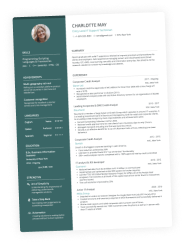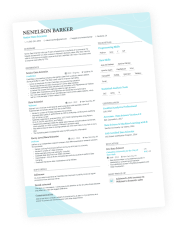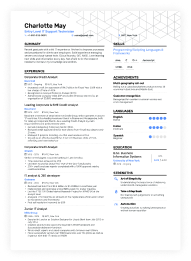Before a hiring manager ever meets you, your resume does the talking. It’s more than a list of past jobs—it’s a glimpse into your experience, goals, and the direction you’re heading. If you’re figuring out how to write a resume that tells your full story, one question might come up: Can you put future jobs on your resume?
Whether you’ve just accepted an offer, are switching industries, or returning to work after some time off, knowing how to make a standout resume that includes future roles, without confusing recruiters or the applicant tracking system (ATS), is key.
Here’s how to list upcoming positions the right way, while keeping your resume honest, refined, and full of potential.
Key takeaways
- You can mention future positions on your resume—if you handle them clearly and honestly.
- Use future roles strategically to frame upcoming transitions, especially if they clarify employment gaps.
- Always differentiate between roles you've started and those you’ve accepted but haven't begun.
- Avoid guessing at responsibilities or inflating expectations—focus on the facts.
- Structure your resume to maintain clarity and trust, especially when passing through ATS filters.
Is it acceptable to put a future job on your resume?
The short answer: Yes—but with caveats.
If you've officially accepted a position with a confirmed start date, there's a tactful way to represent that on your resume. Recruiters are accustomed to career transitions and onboarding timelines, especially when candidates are applying while wrapping up other commitments.
However, you should never list a role as if it’s already started. Misleading titles and unclear date ranges can quickly discredit your resume and cost you trust with recruiters.
A note on good faith:
Only list a future job on your resume if you're confident in the offer’s legitimacy. That means you’ve received a formal offer (not just a verbal one) and your start date is confirmed. Plans sometimes change—companies rescind offers, budgets shift, and roles get restructured—so if there's still uncertainty, it's best to hold off.
Listing a job in “good faith” means you believe in its likelihood and are prepared to answer questions about it honestly if asked.
Is your resume good enough?
Drop your resume here or choose a file. PDF & DOCX only. Max 2MB file size.
When and why you might list a future job
Here are a few scenarios where adding a future position can work in your favor:
You’ve accepted a job offer and have a set start date
Maybe you’ve signed your contract and are waiting for your start date next month. If you're still open to opportunities (or simply updating your resume for networking), mentioning this can pre-empt questions about gaps or current status.
You're relocating or transitioning to a new industry
A future role can serve as a narrative bridge—helping hiring managers understand why you're leaving your current job, moving to a new region, or shifting into a different sector.
You're freelance or in-between roles, and a future gig is your next step
In project-based or consulting careers, showing your pipeline signals stability. Just be sure to note the role’s temporary or upcoming nature.
What if you’re choosing between multiple offers?
If you’re fortunate enough to be deciding between multiple job offers, hold off on listing any future roles on your resume until you’ve officially accepted one. Listing a position you haven’t committed to can backfire—especially if that version of your resume circulates to another company you’re still considering.
Even if you’re leaning heavily toward one role, wait until:
- You've signed the offer letter or contract.
- You’ve received confirmation of your start date.
Until then, it's best to:
- Leave your experience section as-is.
- Use your summary section to reflect your current status in neutral terms (e.g., “currently in transition” or “exploring roles in X field”).
- Save specifics for your cover letter or interviews, where you can speak candidly about your situation.
This avoids premature commitments and ensures your resume reflects only what’s confirmed and accurate.
How to format a future role on your resume
Below, we’ve created a simple template that you can follow for an entry in your work experience section that properly details a future position.
To keep things clear and credible, follow this structure:
Future Job Title (start date expected: month and year)
Company Name | City, State
Start Date (anticipated) – (leave end date blank or write “TBD”)
A brief description noting this is an upcoming role.
Here’s an example in action.
Of course, like any aspect, some things need to be avoided.
What not to do
Avoid these missteps when listing a job you haven’t started:
- Don’t backdate your employment start to appear more experienced.
- Don’t list future duties as achievements—stick to the job description or confirmed responsibilities.
- Don’t fake a job offer to fill gaps. Recruiters can verify employment and will check references.
- Don’t overstate your seniority—your future title should match exactly what’s on your offer letter.
Now that your resume is taken care of, you might be wondering: should you add that future role to LinkedIn too?
Should you include it on LinkedIn too?
If you’ve signed a contract and feel comfortable broadcasting the change, you can update LinkedIn with a future start date. LinkedIn even allows you to schedule job changes to go live on a specific day.
Here’s how to keep things clean:
- Set the correct start date: Use the actual month and year you’ll begin the job.
- Mark it as “Incoming” in the title or description if it’s not active yet.
- Avoid marking the role as current until it officially begins—especially if you're still in your previous position.
If you’re in between jobs, adding the role once it’s confirmed can help explain your current status. But if you're still negotiating or finalizing paperwork, hold off. Unlike a resume, your LinkedIn is public—any premature edits could cause confusion with your current employer or colleagues.
Tips for keeping it ATS-friendly
Applicant tracking systems parse resumes for keywords, titles, and dates. While they’re not the gatekeeping robots people make them out to be, a poorly labeled future role could throw things off—especially if it looks like you’ve already started the job.
To keep your resume clean, clear, and ATS-ready:
- Use clear date labels like “Expected” or “Starting” to indicate future roles.
- If the job hasn’t started yet, place it below your current or most recent position—unless it’s a key part of your career transition and clearly marked as upcoming.
- Don’t use a present-tense date range (e.g., “2024–Present”) unless you’ve started the job.
- Add bullet points sparingly—or not at all—until the role is underway.
PRO TIP
Applicant tracking systems are tools recruiters use to organize and scan resumes—but they’re not the gatekeeping robots they’re often made out to be. You don’t need to game the system to get noticed, and listing a future job won’t automatically disqualify you.
Our ATS research shows that things like resume fonts, colors, columns, and even resume length don’t prevent your resume from being read correctly. Contrary to the myths, ATS doesn’t reject resumes—it just helps recruiters filter and search through them.
So if you’re wondering how to write a resume that mentions a job you haven’t started yet, the key is clarity. Be upfront with start dates, avoid backdating roles, and label future jobs in a way that makes your timeline easy to follow. As long as your resume is structured thoughtfully and tailored to the job, the ATS won’t stand in your way.
If you’re worried about your resume passing, run it through our free ATS resume scanner and see if anything comes up!
Alternatives to listing the role
If including the job feels premature, there are other ways to reference it:
Alternatives and examples
| Alternatives | Examples |
|---|---|
| In your resume profile (ongoing career progression) | “Experienced data analyst with an upcoming role at SynTech, focused on streamlining enterprise data pipelines.” |
| In your resume profile (career advancement) | “Incoming Product Manager at LumaTech with a background in SaaS UX design and cross-functional collaboration. Focused on user-first solutions that drive retention.” |
| In your resume profile (career change) | “IT Support Specialist transitioning into a Cloud Engineering role at SkyLayer (starting July 2026). Currently deepening skills in AWS and Kubernetes.” |
| In your cover letter | “I’ve accepted an offer at SynTech and will begin this summer. I’m excited about the transition and eager to apply my skills in data automation and analytics in the meantime.” |
| In your work gap explanation | “Offer accepted for a Senior Engineer role beginning in July 2026. Current focus: upskilling in Python and DevOps ahead of onboarding.” |
Conclusion
Including a future job on your resume isn’t about showing off—it’s about showing clarity and direction. If you’ve landed your next role, referencing it can contextualize your career path, especially during transitions or job gaps.
Just remember: transparency is key. Be precise about your start date, responsibilities, and status—and avoid presenting the role as already active. Done right, this move adds credibility, not confusion.
Let your resume reflect where you’ve been—and where you’re headed. If you're ready to refresh your resume with confidence, the Enhancv Resume Builder can help you tailor every section for clarity, strategy, and professionalism.
Make one that's truly you.



